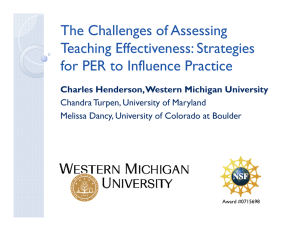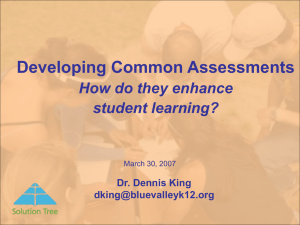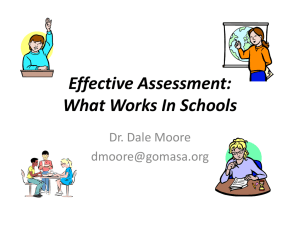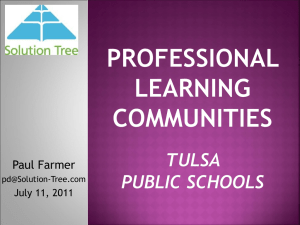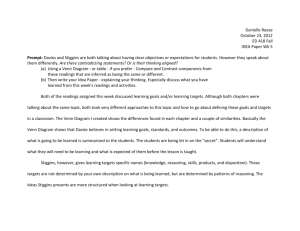Using Learning Targets
advertisement
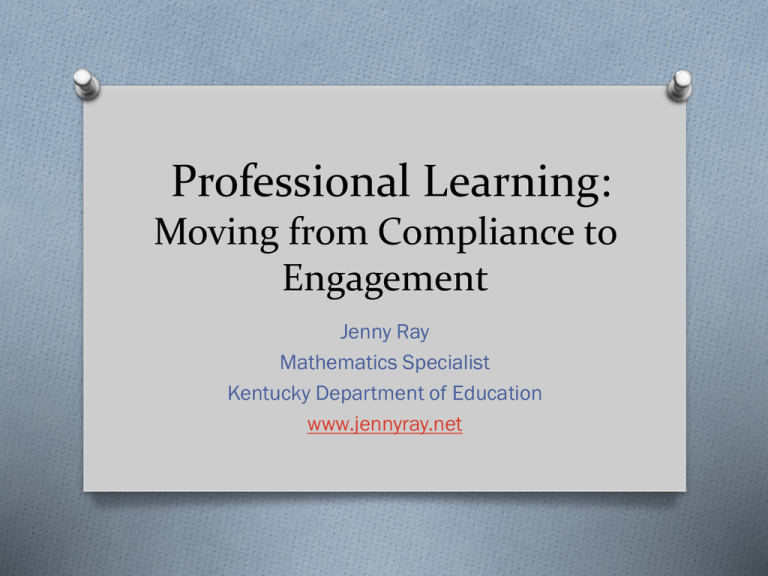
Professional Learning: Moving from Compliance to Engagement Jenny Ray Mathematics Specialist Kentucky Department of Education www.jennyray.net What is the value of using Learning Targets? Using Learning Targets Effectively in the Classroom Presentation Adapted from PIMSER By Jenny Ray 60-Second Free Write O Take a minute (literally) to write how you use learning targets in your classroom. O Share with an elbow partner at your table and develop a response to the question, “What is the value of using learning targets?” Research-based Strategies 5 Research-based strategies that significantly improve student learning: Clarifying and sharing learning intentions and criteria for O O O O success Effective Questioning (Engineering effective discussion, questions, activities, and tasks that elicit evidence of learning) Descriptive Feedback that moves learners forward Peer assessment (Students as instructional resources for one another.) Self-assessment (Activating students as owners of their own learning.) “Students who can identify what they are learning significantly outscore those who cannot.” Robert J. Marzano Where is the target? Learning/Achievement Targets One definition: Statements of what we want students to know and be able to do. CLEAR TARGETS Assess what? What are the learning targets? Are they clear? Are they good? O Are the student learning targets assessable? O Are the student learning targets focused— are there too many? O Are they clear to students? O Are they appropriate for grade level standards? O Will students know when they’ve reached the target? Educators & Students must be able to answer…… O Where am I going? O Where am I now? O How can I close the gap? Is this a StandardsFocused Target? What do you think? O I can complete a senior project. O I can build a bird Feeder. O I can use a band saw safely. O I can analyze a lab report. O I can construct a diorama. O I can set up linear equations that model real-life situations. A Mathematics Example • Math • Decimals Subject Topic Assignment • Page 152 in the book • Going on a decimal hunt • I can read decimals and put them in numerical order Activity Learning Target “Teachers who truly understand what they want their students to accomplish will almost surely be more instructionally successful than teachers whose understanding of hoped-for student accomplishments are murky.” -W. James Popham How do Learning Targets connect to our assessment practices? Learning Triangle Learning Target STANDARD Assessment Learning Tasks Some Challenges…. O How can we use assessments to help the student believe that the target is within reach? O How can we use assessments to help the student know if they have met the target? O How can we use formative assessments of the target to adapt our teaching? Mrs. Addison O Let’s watch a video clip of a teacher using learning targets in her high school classroom to differentiate and guide instruction. O Do you see students taking ownership of their own learning? O What else do you notice? (Jot down your thoughts while you watch the video.) The single most common barrier to sound classroom assessment is the teachers lack of vision of appropriate achievement targets within the subjects they are supposed to teach. -Rick Stiggins Mrs. Cummins’ Students Hear what students say about their use of Learning Targets Commit & Toss Activity O Please answer honestly on the worksheet entitled “Prerequisites to Accurate SelfAssessment and Meaningful Goal Setting” (an excerpt from Stiggins’ book, Getting Started with Seven Strategies of Assessment for Learning) O Once you have answered the questions, please make your paper into a snowball and toss it across the room to no one in particular. O Pick up a ‘snowball’ that is not your own and toss it in the same manner. Human Bar Graph O Now, open your paper that you have retrieved. O For each numbered statement, 1-7, we will make a human bar graph to formatively assess where you are as a faculty in response to each question. O So, for #1 and ONLY #1, choose the poster under which to stand that represents the choice on your paper… O All of the time, Some of the time, Not yet A look at the Results… O 1. Students have a clear vision of the learning targets. Targets are communicated to them in language they understand. Rubrics are designed to function as effective feedback about level of qualaity and are written in language students can understand. A look at the Results… O 2. Instruction centers on the learning targets. O 3. Assignments and assessments align directly with the intended learning and instruction provided. O 4. Students have practice evaluating anonymous work samples…differentiating between strong and weak work, identifying problems with correctness or quality, flaws in reasoning , and misconceptions. A look at the Results… O 5. Students receive feedback during the learning, pointing out strengths and offering guidance on improvement. Students have opportunities to act on the feedback before a graded event. O 6. Assignments and assessments are designed so that students can interpret the results in terms of the intended learning. The results function as effective feedback. A look at the Results… O 7. Students have practice offering each other effective feedback. O Which of these prerequisites is your highest priority to address, based on the results? Learning Targets OKnowledge OReasoning OPerformance/ skills OProducts Knowledge Targets Mastery of substantive subject content where mastery includes both knowing and understanding it. Knowledge Examples O Identify metaphors and similes O Read and write quadratic equations O Describe the function of a cell membrane O Know the multiplication tables O Explain the effects of an acid on a base Reasoning Targets The ability to use knowledge and understanding to figure things out and to solve problems. Reasoning Examples O Use statistical methods to describe, analyze, evaluate, and make decisions. O Make a prediction based on evidence. O Examine data/results and propose a meaningful interpretation. O Distinguish between historical fact and opinion. Performance/Skill Targets The development of proficiency in doing something where the process is most important. Performance/Skill Examples O Measure mass in metric and SI units O Use simple equipment and tools to gather data O Read aloud with fluency and expression O Participates in civic discussions with the aim of solving current problems O Dribbles to keep the ball away from an opponent Product Targets The ability to create tangible products that meet certain standards of quality and present concrete evidence of academic proficiency. Product Examples O Construct a bar graph O Develop a personal health-related fitness plan O Construct a physical model of an object O Write a term paper to support a thesis Clear Targets Clear targets help us: O Recognize if the formative assessment adequately covers and samples what we taught. O Correctly identify what students know/don’t know, and their level of achievement. O Plan the next steps in instruction. O Give meaningful descriptive feedback to students. Clear Targets (continued) O Have students self-assess or set goals likely to help them learn more. O Keep track of student learning target by target or standard by standard. O Complete a standards-based report card. Moving from Compliance to Engagement O How may I assist you in your journey? O Contact me: O Jenny.ray@education.ky.gov O www.jennyray.net O 606-782-0400



